|

 Up
Up 
 Transitional
Transitional
Model AB 
(You are here.)



  Need
to Need
to
find your
bearings?
Try
these
navigation aids:
If
this is your first
visit, please stop by:
Something
to share?
Please:



|
|
Available in Française, Español, Português, Deutsch, Россию,
中文,
日本, and others.
 hile
teaching the first U.S. military pilots at College Park, Maryland in
the fall of 1909, Wilbur Wright attached a horizontal surface ahead
of the twin rudders of the Military Flyer, hoping to improve the longitudinal or pitch stability of the aircraft.
Orville, who was
flying in Germany at the same time, did the same thing, only he affixed
the surface behind the rudder of a standard
Model A. The experiment showed promise,
and Orville
next replaced the fixed rear surface with a flexible elevator, giving the
airplane an elevator in the front and rear, a configuration very much
like Curtiss and Farman aircraft at the time. hile
teaching the first U.S. military pilots at College Park, Maryland in
the fall of 1909, Wilbur Wright attached a horizontal surface ahead
of the twin rudders of the Military Flyer, hoping to improve the longitudinal or pitch stability of the aircraft.
Orville, who was
flying in Germany at the same time, did the same thing, only he affixed
the surface behind the rudder of a standard
Model A. The experiment showed promise,
and Orville
next replaced the fixed rear surface with a flexible elevator, giving the
airplane an elevator in the front and rear, a configuration very much
like Curtiss and Farman aircraft at the time.
In the winter and early spring of 1910, Orville trained the Wright
exhibition team -- called the "Wright Fliers" -- in Montgomery, Alabama
at the site of what is now Maxwell Air Force Base. The students flew
what historian Wick Wright, the nephew of the Wright brothers, would
later call the "Model AB." It had two elevators, one at the front and
the other at the back of the airplane. The rear control surfaces were
supported by a wire-braced rectangular frame or empennage. This was a transitional design
that the Wrights considered experimental. Arch Hoxsey, in fact was
assigned to fly a "convertible" aircraft that could be set up with the
elevator in front, in back, or in front
and back. Photos show Hoxsey flying during the summer of 1910 with the
aircraft in all these configurations. The Wrights most likely did this
so one pilot could gain flying experience with all three configurations
and report on the stability and controllability of each.
Sometime during the summer, the Wrights also added wheels to the
Model AB, possibly after reading reports from Lt. Benjamin Foulois
who had installed wheels on the
Military Flyer. By the fall of 1910, the Wrights were finished
experimenting with the Model AB. They had decided that the elevator
worked best when positioned at the back of the aircraft and that
wheels were more convenient than the catapult launching system. On
October 22, 1910 at the Belmont Aviation Tournament in New York, the
Wright introduced their new airplane design, the "Model
B." It was the first of their aircraft to have a conventional
tail and landing gear.
Wright Model AB specifications:
- 41 ft (12.3 m) wingspan
- 6.5 ft (198 cm) chord
- 6
ft (183 cm) separation
- 510
sq ft (46.7 sq. m) wing area
- 1:20 camber
- 70
sq ft (7.7 sq m) double horizontal front rudder
- 35
sq ft (3.8 sq ) horizontal rear elevator
- 23
sq ft (3.2 sq m) twin movable vertical rear rudders
- 34
ft (10.4 m) overall length
- 830
lb (362.9 kg) total weight (without pilot)
- 4
cylinder engine, 31 hp at 1425 rpm
- Two
contra-rotating propellers, 8-1/2 ft (244 cm) long, turning at
445 rpm
- 37
mph (60 kph) average speed
References:
- McFarland, Marvin W. (ed), "The papers of Wilbur and Orville
Wright." McGraw-Hill Book Co., New York, 1953, p 1197.
|
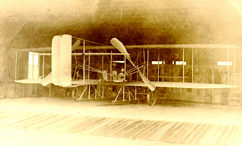
The 1909 Military Flyer in its hangar at College Park. Wilbur has
removed the upper surface from the front elevator and has attached
it to a post just ahead of the rear rudder.
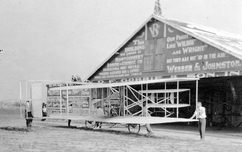
The first true Model AB makes its appearance at the Wright Flying
School in Montgomery, Alabama in the late winter of 1910. It has two
functioning elevators with a total of three horizontal control
surfaces – two in the front and one in the rear. The rear elevator
trails the rudder.
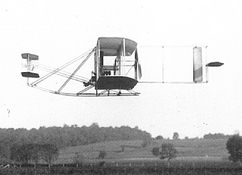
A Wright Model AB in level flight over Simms Station.
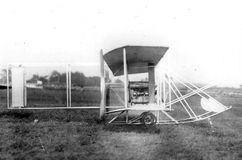
Here again is Hoxsey's aircraft in St. Louis, but it's set up with a
single elevator surface at the rear of the aircraft.

The Model AB also flew in Europe. On 2 June 1910, the Honorable
Charles Rolls (of Rolls-Royce) piloted a Wright AB across the
English Channel and back again nonstop.
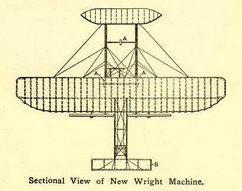
An illustration of the Model AB, possibly the aircraft Orville
tested in Germany in 1909.
|
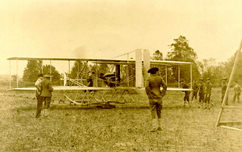
In this position, the surface is stationary or "fixed." It cannot be
tilted or flexed like a control surface.
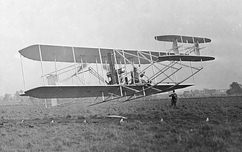
The Wright built a second Model AB and flew them both at the Flying
School at Simms Station (Huffman Prairie) in the spring of 1910.
They continued to use their catapult and rail to launch the
airplanes.
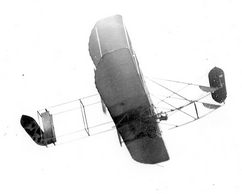
When the Wright Fliers began to give exhibition flights in 1910,
Arch Hoxsey flew a test aircraft that could be configured with the
elevator surfaces at the front or rear of the aircraft. Here, he
flies in St. Louis with the surfaces at both ends. Note that he has
added a set of wheels to the undercarriage and has moved the
"blinkers" to the forward braces..
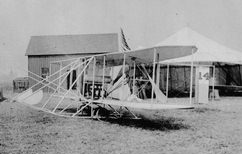
At the Belmont Aviation Tournament in the fall of 1910, Hoxsey's
convertible aircraft was assembled with just one elevator at the
rear. The only thing that distinguished it from the Wright Model B
that the Wright brothers introduced at this air meet was the
extended front skids and the semi-circular blinkers. The Model B had
shorter skids and triangular blinkers.
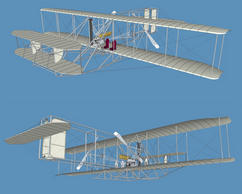
Front, side, top, and perspective drawings of the Wright Model AB.
|